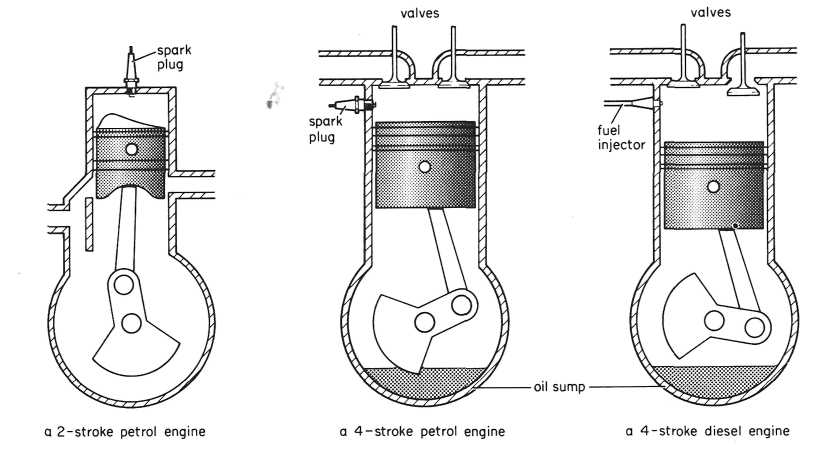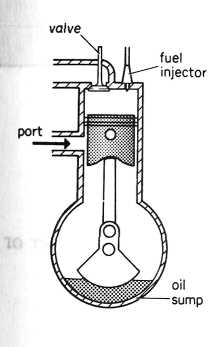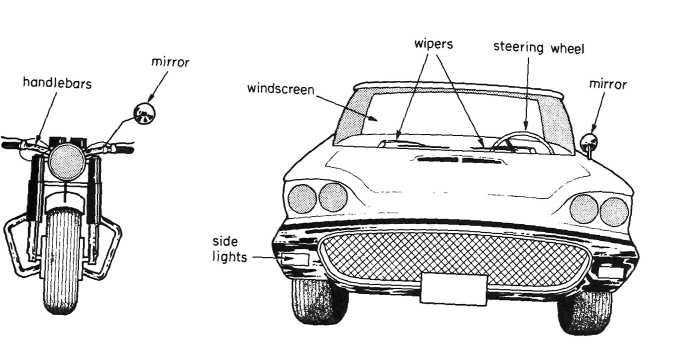
- •Section b gasoline (petrol) engines
- •Section c diesel engines
- •Section b water and its boiling point
- •C) molecules in motion
- •Section d engine-cooling system
- •Section b lubrication
- •Section c engine lubricating system
- •Section d filters
- •Unit four electricity Section a electrolysis
- •Uses of Electrolysis
- •Section b batteries
- •Section c automobile electric system
- •Section d battery-powered automobiles
- •Section b ferrous metals
- •Tensile strength and hardness section c
- •Section d aluminium bronze
- •Grammar exercises
- •Unit 1 advantages and disadvantages of diesel engines
- •Unit 2 comparative characteristics diesel and gasoline engines
- •Unit 3 basic parts of the automobile
- •Unit 4 where diesel engines are used
- •Unit 5 Temperature Regulators of Cooling System
- •In machihes and machinery.
- •Unit 8 the instruments in a car
- •Unit 9 Battery chargers
- •Vocabulary Список сокращений
- •Literature used
- •Contents
Section c diesel engines
A diesel engine is a machine which produces power by burning oil in a body of air which has been squeezed to a high pressure by a. moving piston. Such engine operates on the principle of compression ignition. It is known by the name of their inventor, Rudolph Diesel, who patented this idea in 1892. Diesel engines are especially suitable where an independent source of power is required, as in ships, locomotives, mobile equipment of all sorts and isolated power plants.
How a Diesel Engine Works.
As far as the sequence of strokes the operating cycles of four-stroke diesel engine and the four-stroke petrol engine an identical. But there is a major difference in principle. We see it later.
Now let's see what happens inside the engine, step by step.
First, air must be got into the cylinder. This is the intake stroke. On that stroke the piston is moving down. Intake valve is opened.
Second, the air must be compressed to high pressure. This is the compression stroke. On that stroke the piston is moving upward. Both valves are closed.
In a diesel engine the air is compressed so much that it becomes hot and ignites oil that is sprayed into it. This is the power stroke on which both valves are closed.
And this is a fundamental difference between a diesel engine and a gasoline engine. In a gasoline engine a spark is used to ignite the combustible mixture, while in a diesel engine the fuel ignites by itself just from contact with air that is very hot because it has been highly compressed.
Now begins the exhaust stroke. Moving upward the piston pushes the spent gases; out of the cylinder. On that stroke the exhaust valve is opened. Now the cylinder is ready to begin the operation again.
Exercise 5 Answer the following questions. You may choose the correct answer from those given in parenthesis.
Who was the inventor of a diesel engine?
What property of gases is the operation of diesel engines based on?
What strokes does the working cycle of a typical diesel engine consist of?
In what way is the fuel ignited in a diesel engine?
Do the diesel engines always work on liquid fuels?
(1. It ignites from the contact with very hot air that has been highly compressed. 2. Yes, usually they do. 3. It is based on the property of gases to be compressed to a very high pressure. 4.They are the following: intake stroke, compression stroke, power stroke and exhaust stroke. 5. Rudolph Diesel, a German engineer)

All motor vehicles have an engine. There are two types of engine. There are petrol engines and there are diesel engines. There are three engines in the diagram. There is a 2-stroke petrol engine on the left. There is a 4-stroke petrol engine in the middle and there is a 4-stroke diesel engine on the right.
There are spark plugs in both the petrol engines. There are spark plugs in all petrol engines. Diesel engines do not have spark plugs. They have fuel injectors.
There are valves in both the 4-stroke engines. There are always valves in 4-stroke engines. There are no valves in the 2-stroke petrol engine. A 2-stroke petrol engine never has valves.
There is no oil sump in the 2-stroke engine. There is oil in the fuel. Both the 4-stroke engines have an oil sump. There is no oil in the fuel.
Exercise 6 Complete this table from the diagrams and the text above:
|
oil sump |
valves |
fuel injector |
spark plug |
2-stroke petrol engine |
no |
|
|
|
4-stroke petrol engine |
|
|
|
|
4-stroke diesel engine |
|
yes |
|
|
Now look at these examples.
There is no oil sump in the 2-stroke petrol engine. There are valves in the 4-stroke diesel engine.
Make ten sentences from the table in the same way.

This is of a 2-stroke diesel engine. Now look at this example.
a) There is a fuel injector in a 2-stroke diesel engine.
b) A 2-stroke diesel engine has a fuel injector.
These two sentences have the same meaning. Complete these sentences in the same way.
1. There is one valve in this engine. This engine ........valve.
2. There is an oil sump in a 2-stroke diesel engine. A........
3. There is a fuel injector on all diesel engines. All …
4. This engine has one port. There........
5. This engine has no spark plugs. There ….
6. Diesel engines have no spark plugs. There …
Exercise 7 Make up statements with the words below. Examples:
A) Triangle/three sides. A triangle has three sides. B) Hammers/a blade Hammers do not have a blade.
1) Diesel engines/a fuel injector
2) Petrol engines/spark plugs
3) 2-stroke petrol engines/an oil sump
4) A 4-stroke engine/valves
5) A 2-stroke petrol engine /valves
Exercise 8 Look at the picture of a motorcycle and a car.

Now complete this description.
1. In the picture there is a motorcycle on ….and there is a-------on the right. 2. There is a …headlight on the front of the motorcycle. 3. The car ….. two headlights at........ .
4. The car … two wipers. 5 There … no windscreen on the motorcycle and it has … wipers. 6. There … two side lights on the front of … .7.There …no side lights on the front of a … . 8. … a steering wheel in the car. 9. A motorcycle … no steering wheel.
10. A ………has handlebars.
Exercise 9 Check up whether you know the following words and expressions.
A stroke, a spark plug, a fuel injector, a valve, a sump, a port, a hoist, a jack, a bell, a table, a mirror, a wiper, a windscreen, a steering wheel, handlebars, fuel, both, on the left, on the right, under, over, beside.
UNIT TWO
FACTS ABOUT MATTER
Section A
THREE STATES OF MATTER
Under normal conditions, there are three states of matter: the solid state, the liquid state and the gas state. Iron, nickel and other metals are normally solids. Water is normally a liquid and carbon dioxide is normally a gas.
METALS |
|
m. p. |
Iron (Fe) Nickel (Ni) Tin (Sn) |
|
1,535°C 1,453°C 232°C |
Fig. (a) |
|
|
LIQUIDS |
f. p. |
b. p. |
Water (H2O) Bromine (Br) Benzene (C6H6) |
0°C 100°C -7°C 5°C 80°C |
58°C |
Fig. (b) |
|
|
GASES |
f. p. |
Ь. p. |
Carbon Dioxide (CO2)
Oxygen (O) Hydrogen (H) Fig.(c) |
-78°C
-219°C -259°C |
-57°С
- 183°С -253°С
|
Fig. (a) gives the melting points (m. p.) of some metals. Iron has a high melting point. It melts at 1,535°C. Nickel has a high m. p. Tin has a low m. p. It melts at 232°C.
Fig. (b) gives the freezing points (f. p.) and the boiling points (b. p.) of liquids. Water is normally a liquid. It boils at 100°C, i.e. it becomes a gas above this temperature. It freezes at 0°C, i.e. it becomes a solid below this temperature. Bromine is normally a liquid but it has a low b. p. It boils at 58°C and it freezes at — 7°C.
Fig. (c) gives the f. p. and the b. p. of gases. At low temperatures, a gas becomes a liquid. Oxygen liquefies at — 183°C. Carbon dioxide is normally a gas but it is often used in the liquid or the solid state. CO2 liquefies at -57°C. It solidifies at -78°C.
Exercise 1 Are these statements true or false?
1. The solid state, the liquid state and the gas state are the three normal states of matter.
2. Metals are normally liquids.
3. Iron liquefies at 1,535°C.
4. Tin has a high m. p.
5. Water boils at 0°C and it freezes at 100°C.
6. Bromine becomes a gas above — 7°C.
7. Benzene becomes a gas above 80°C.
8. CO2 normally solidifies below -78°C.
9. Oxygen normally becomes a liquid above -183°C.
10. Hydrogen is in the liquid state between -253°C and -259°C.
Exercise 2 Check up whether you know the following words and expressions.
A condition, normal, give, a fact, low, melt, a state, boil, a figure (fig.), above, freeze, below, become,
a melting point (m. p.), about, liquefy, a freezing point (f. p.), solidify, a boiling point (b. p.), Celsius, (Centigrade), dissolve, zero (0), conduct, a magnet, minus (—), corrode, radiate, the Sun, ice, reflect, matter, electricity, expand, some, heat, refract.
LANGUAGE NOTES: You may say: metal, a metal, gas, a gas, liquid, a liquid, wood, a wood, iron, an iron… But you cannot say: a water, a benzene, a hydrogen.
